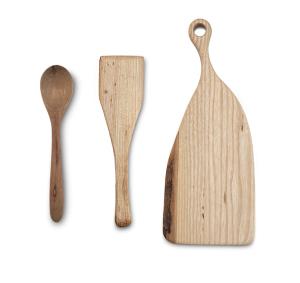

No tree grows in anticipation of being felled, sawn, planked, planed, turned, sanded, drilled, moulded, routed, charcoaled or burned. Yet, in considering the legion applications of ash timber, one could be forgiven for thinking nature actually designed the tree to satisfy the diverse needs of human beings. Over the millennia we have used ash (Fraxinus excelsior) to make tool handles, chairs, ladders, boat tillers, looms, sieve rims, fishing rods, landing nets, clothes props, hop poles, orthopedic frames, stays for bells in church towers, walking sticks, catapults, ploughs, harrows, canoe paddles, hockey sticks, hurley sticks, tennis rackets, skis, snowshoes, baseball bats, snooker cues, the rims of wooden wheels, cart axles, the frames of early motor cars, bows, bicycle frames, arrow shafts and spears. And that's not the half of it. The list goes on, and on.
Were it not for modern, man-made materials like plastic, light metal alloys and carbon, ash would still figure highly in our daily lives. Instead, we know of ash today largely because the tree is under threat from a disease called ash dieback'. For forestry purposes, the UK is divided into 10km squares and the disease is now present in just over 25% of these squares. It is spreading stealthily across the land. It is reasonable to assume that a large proportion somewhere between 60% and 90% - of our 125 million or so ash trees will be affected by the disease in the next half century. Add to this, the threat of the emerald ash borer, a rather beautiful but voracious green beetle. This beetle was introduced by accident to North America in 2002: it has since killed over 100 million ash trees. The same beetle is in Russia now, and advancing this way. All in all, the ash is in deep trouble. It is unjust, for a tree species that seems to have been selflessly committed to the human cause for so long.
To tell the story of man's extraordinary, intense relationship with this tree, I felled an ash near my home in the Black Mountains, South Wales in February 2013. I then distributed the timber from the tree to artisans and makers across Europe, to be made into artefacts and wares, many of which are now part of my life. I used everything but the squeal', as country folk used to say when butchering a pig. This is important. In wasting almost nothing, I wanted to exalt the worth of a single ash, and honour my own tree.
In the end, I got 44 different uses, and several hundred individual items, out of one tree. My ash has been converted into a toboggan, catapults, cricket stumps, bookmarks, axe handles, components of surfboards, chopping boards, a set of dominoes, kitchen work tops, panelling, benches, tent pegs, spoons and coat racks. I made charcoal, firewood and kindling out of the sticks and branches. Some of the sawdust went to animal bedding; yet more of the sawdust was used to smoke meat and fish. Some of the finest timber from the stem of my tree went to Phill Gregson, one of the last traditional wheelwrights in Britain, for cartwheel felloes. Andy Dix, a local cabinetmaker, designed and made a desk for me: I am sitting at the desk to write this. I left some of the wood to rot and return to the earth, in the woodland, where the tree fell.
Individually, these objects speak of the skill and the idealism of the artisans and craftspeople who made them, people whose knowledge hints at a past when the affinity between humans and nature was at a more sensitive pitch. Together, the objects speak of the long and creative relationship between humankind and ash, an accord of intense intimacy recurring from one civilization to another over millennia. It's been a deeply satisfying venture that has left me feeling rooted to a place in the fast turning world.
When this project was finished, and the book written, I felt sad that my time with this tree was ending. But of course, it wasn't: the tree has been immortalised in my desk and the kitchen work tops, in the toboggan my kids use after snowfalls, and in the spoons, book marks, bread boards and bowls that we all use everyday. More than that, my new rapport with the ash has only just begun.
Words by Robert Penn.
Robert's book, The Man Who Made Things Out of Trees,is published by Penguin.
Rob is speaking at the Hay Festival on Monday 30th May.
Add a comment